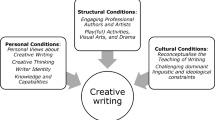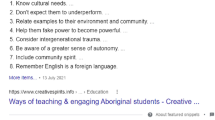Abstract
This qualitative study looks at 23 elementary preservice teachers’ roles as science teachers and the importance of understanding linguistic diversity for science instruction. Using individual and group reflection papers, two important points are made that reflect the importance of preparing preservice teachers in science. Explicit conversations and tasks to connect science and linguistic diversity to science teaching suggests that preservice teachers need to discuss the implications of scientific language and linguistic diversity in terms of power and science teaching and learning in urban classrooms.
Similar content being viewed by others
References
Banks, J.A. (1994).Multiethnic education: Theory and practice (3rd ed.). Boston: Allyn & Bacon.
Barrett, M. B. (1994). Preparation for cultural diversity: Experiential strategies for educators.Equity and Excellence, 26(1), 19–26.
Bullock, L. D. (1997). Efficacy of a gender and ethnic equity in science education curriculum for preservice teachers.Journal of Research in Science Teaching, 34(10), 1019–1038.
Calabrese Barton, C., & Yang, K. (2000). The culture of power and science education: Learning from Miguel.Journal of Research in Science Teaching, 37(8), 871–889.
Cochrane-Smith, M. (2004).Walking the road: Race, diversity, and social justice in teacher education. New York: Teachers College Press.
Coffey, A., & Anderson, P. (1996).Making sense of qualitative data. Thousand Oaks, CA: Sage.
Collins, P. H. (2000). What’s going on? Black feminist thought and the politics of postmodernism. In E. A. Pierre & W. S. Pillow (Eds.),Working the ruins: Feminist poststructural theory and methods in education (pp. 41–73). New York: Routledge.
Creswell, J. W. (1998).Qualitative inquiry and research design: Choosing among five traditions. Thousand Oaks, CA: Sage.
Crotty, M. (1998).The foundations of social research: Meaning and perspective in the research process. London: Sage.
Delpit, L. D. (1988). The silenced dialogue: Power and pedagogy in educating other people’s children.Harvard Educational Review, 58(3), 280–298.
Delpit, L. (1995).Other people’s children: Cultural conflict in the classroom. New York: The New Press.
Garmon, M. A. (2004). Changing preservice teachers’ attitudes/beliefs about diversity: What are the critical factors?Journal of Teacher Education, 55(3), 201–213.
Gomez, M. L. (1993). Prospective teachers’ perspectives on teaching diverse children: A review with implications for teacher education and practice.Journal of Negro Education, 62(4), 459–474.
Guba, E. G., & Lincoln, Y. S. (1989).Fourth generation evaluation. Newbury Park, CA: Sage.
Health, S. B. (1983).Ways with words: Language, life, and work in communities and classrooms. Cambridge, UK: Cambridge University Press.
Hodgkinson, H. (2002). Demographics and teacher education.Journal of Teacher Education, 53(2), 102–105.
Houser, N. O., & Chevalier, M. (1995). Multicultural self-development in the preservice classroom: Equity education for the dominant culture.Equity and Excellence, 28(3), 5–13.
Irvine, J. J. (2003).Educating teachers for diversity: Seeing with a cultural eye. New York: Teachers College Press.
Ladson-Billings, G. (1994).The dreamkeepers: Successful teachers of African American children. San Francisco: Jossey-Bass.
Lee, O. (2003). Equity for linguistically and culturally diverse students in science education: A research agenda.Teachers College Press, 10(3), 465–489.
Lee, O., & Fradd, S. H. (1998). Science for all, including students from non-English language backgrounds.Educational Researcher, 27, 12–21.
Miles, M. B., & Huberman, A. M. (1994).Qualitative data analysis. Thousand Oaks, CA: Sage.
Moore, F. M. (2006). Multicultural preservice teachers’ views of diversity and science teaching.Research and Practice in Social Sciences, 1(2), 98–131.
Moore, F. M. (2007). Language in science education as a gatekeeper to learning, teaching, and professional development.Journal of Science Teacher Education, 18(2), 319–343.
Moore, F. M. (2008). Preparing preservice teachers for urban elementary science classrooms: Challenging cultural biases toward diverse students.Journal of Science Teacher Education, 19(1), 85–109.
Moore, F. M. (In press). Agency, identity and social justice education: Preservice teachers becoming agents of change in urban elementary science classrooms.Research in Science Education.
National Center for Education Statistics (NCES). (1997).America’s teachers: Profile of a profession, 1993–1994 (NCES 97-460). Washington, DC: U.S. Department of Education, Office of Educational Research and Improvement.
Patton, M. Q. (2002).Qualitative evaluation and research methods. Newbury Park, CA: Sage.
Posner, J., Strike, K., Hewson, P., & Gertzog, W. (1982). Accommodation of a scientific conception: Toward a theory of conceptual change.Science Education, 66(2), 211–227.
Sleeter, C. E. (2001). Preparing teachers for culturally diverse schools: Research and the overwhelming presence of whiteness.Journal of Teacher Education, 52(2), 94–106.
Smith, E. L. (1990). A conceptual change model of learning science. In S. Glynn, R. Yeany, & B. Britton (Eds.),Psychology of the learning science (pp. 43–63). Hillsdale, NJ: Lawrence Erlbaum.
Snyder, T. D., Tan, A. G., & Hoffman, C. M. (2004).Digest of education statistics, 2003. (NCES 2005-025). Washington, DC: Government Printing Office.
Strauss, A., & Corbin, J. (1998).Basics of qualitative research: Techniques and procedures for developing grounded theory. Thousand Oaks, CA: Sage.
Young, B. A. (2000). Characteristics of the 100 largest public elementary and secondary school districts in the United States: 1998–1999 (NCES 2000-345).Education Statistics Quarterly, 2(3). Retrieved May 12, 2008, from http://nces. ed.gov/programs/quarterly/vol_2/2_3/elem_100/largest.asp.
Author information
Authors and Affiliations
Corresponding author
Rights and permissions
About this article
Cite this article
Moore, F.M. The role of the elementary science teacher and linguistic diversity. J Elem Sci Edu 20, 49–61 (2008). https://doi.org/10.1007/BF03174708
Accepted:
Issue Date:
DOI: https://doi.org/10.1007/BF03174708




